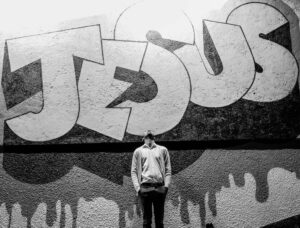Baptism rates among teenagers and young adults who grew up going to church have plummeted. Why?
In response to this drop-off in baptisms, I could talk about what faith formation is, the role of ritual or how to make baptism feel less like graduation, but I think that would just be rearranging the deck chairs on the Titanic. Instead, I want to talk about a concept I came across a couple of years ago and haven’t been able to get out of my mind. We, as a culture, are driven by what professor and author Andrew Root calls the “journey of authenticity.”
Psychology Today magazine says the following about this journey: “Individuals considered authentic are those who strive to align their actions with their core values and beliefs with the hope of discovering, and then acting in sync with, their true selves.”
The concept is not new, either. Willam Shakespeare said, “This above all; to thine own self be true.”
Irish poet Oscar Wilde said, “Be yourself. Everyone else is taken.”
Ralph Waldo Emerson said, “Do not follow where the path may lead. Go, instead, where there is no path and leave a trail.”
More recently, Michael Jordan said, “Authenticity is about being true to who you are.”
The assumption at play is that each person has their own right to define for themselves what it means to be human. The task of growing up is to find your authentic self.
This journey can be great for establishing our autonomy, setting boundaries, finding freedom in who we are and living with integrity, but the journey is complex. If our primary task as humans is to identify our authentic selves, how do we do that? If the younger generations are to go where there is no path, as Emerson said, where do they even start?
The path of identity formation is like trying on hats. People try on different hats to see which fits. Adolescents and young adults have been doing this for generations, and this is all good and normal and expected.
But it’s harder today than it was for us who took the journey years ago, because now there are almost no guidelines.
There are no routes to follow—or there are infinite routes—to our authentic selves, because we are all supposedly making our own paths. Adolescents and young adults are not trying to conform to any one group’s set of expectations, because conformity to someone else’s path is not authentic.
Ultimate performance
People seek feedback as they try on different hats, performing values and identity. Performing is a risky and exhausting endeavour, especially when you are performing nothing less than your potential authentic self. What if you are rejected?
It gets harder still because the audience is unclear. The audience is a bunch of other people trying to blaze their own trails to an unknown destination of selfhood. It’s impossible to predict what they will affirm. The criteria are unknown.
Then throw in social media. Young people end up in their bedrooms on their phones, in full public view, seeking the affirmation of an unknown audience with unknown values, and watching strangers doing the same, all of them seeking to be “liked.”
The journey of authenticity for teenagers and young adults is a remarkably difficult task, but that is not their fault; it’s ours.
Here come the parents
If we’re raising kids, which I am, how do we help them find their way? How do we help them discover their wings? This question is ironic, because the journey to authenticity, by definition, is individual. You have to find your own path; your parents can’t do it for you. But we parents still try, oh do we try. And the grandparents are close behind.
What we do is we help our kids find their “thing.” It’s usually an extra-curricular activity: hockey, dance, swimming, curling, choir, piano, axe throwing or sometimes even church, but rarely so. In the case of my own kids, it’s piano, swimming, soccer and school sports.
We parents spend untold amounts of money, time and energy helping our kids find their “thing,” in the hope that this will help them thrive and find their true selves.
Yes, we hope it also teaches them teamwork and self-confidence and commitment, which are all good, but we parents also move heaven and earth for our kids to excel, because we hope it will give them what we think they need.
Why else do we enlist our 3-year-olds in gymnastics? Why drive our kids an hour, one way, for indoor soccer all winter? Why are both parents in different cities every other weekend for hockey tournaments, while paying a second mortgage to cover hockey fees? Why yell at refs who get in the way of our kids’ journey?
We leave family gatherings early for the “thing.” We skip school concerts for the “thing.” We wake our kids up at 6 a.m. on weekends for the “thing.” I’ve seen families plan funerals around “the thing.”
By doing this, we risk teaching our children that their “thing” is the most important thing in the world.
And we call it good.
Lest we adults get smug, we, too, swim in the cultural waters of the “journey of authenticity.” We, too, bend our schedules around our “things.” We, too, perform our identity. Only we know that, at our age, we’re never going to be great ballet dancers or axe throwing champions (although, at 40, I still have a chance at winning an Olympic medal in curling).
Our “things” look like recipes, recreation, renovations and resorts, to borrow phrasing from journalist George Monbiot. Our Instagrams may well be a mix of our kids’ performances and our own.
No wonder the world can seem a bit wonky. Maybe even selfish. Because at any age, living and performing our authentic selves is a pretty individualistic pursuit, isn’t it?
And if you’re not thoroughly depressed yet, don’t worry, it gets a little worse before it gets better.
Faith formation and church don’t stand a chance in this mix. The journey of authenticity eats faith formation and church for breakfast. Here’s why.
1) In our effort to be our true selves, we seek ideological purity. We identify those who are not like us and we define ourselves against them. We seek pure communities, either in person, or, more likely, online. We self-segregate.
On one hand, this is a move filled with integrity. I do this all the time. There are certain restaurants in my hometown from which I do not order because I find their views abhorrent.
On the other hand, the quest for purity prevents us from participating in authentic community, such as church, in which the group includes people with a range of views and values.
2) For younger folks, the journey to authenticity involves trying on numerous hats over time. It is, by nature, an ongoing process. Baptism does not fit. Committing fully and permanently to one hat is not the way of our culture.
In this context, not getting baptized is actually a move filled with integrity because it allows for the evolving, individualistic journey. It’s a move that we’ve driven them to, literally, because we’ve driven them to their “thing,” and it probably wasn’t church.
3) The notion of identity in Jesus is another factor that puts the authenticity journey at odds with faith.
Following Jesus demands a lot of us. It demands that we spend time with people not like us. Harder still, it demands that we give up part of our own identity, and adopt someone else’s identity that of Jesus.
“It is no longer I who lives but Christ who lives in me” (Gal 2:20). We as the body of Christ are supposed to give up part of our own journey of authenticity and follow another path.
And the message of Jesus does not always jibe. “Blessed are the poor” (who probably can’t afford the “things” that we think are vital to our own children’s development).
“Pray for those who hate you.”
“Love your neighbor as yourself.”
“The first are last and the last are first.”
“Consider others better than yourself.”
These messages of Jesus do not fit a value system based on living our values through our “things.” To say, “Jesus is Lord and thus I am giving Jesus the right to tell me how to live” is pretty much the opposite of the “journey of authenticity.”
How can we be surprised if teenagers and young adults don’t sign up to be baptized? We tell them to follow their own paths, and then wonder why they don’t follow the path of Jesus.
Hope
To counter this, here are some things that give me hope.
I have hope in God and Jesus and Spirit.
I have hope that we in the church are a tradition that can talk about identity and true selves. It’s part of our centuries-old lingo.
I have hope that we can provide a real-life in-person audience for our youth that’s rooted in long-term, unconditional love and grace.
I have hope that we who follow Jesus can live a passionate life in the kin-dom of God, giving back that which we have received, and modeling this to our kids.
And while hope is important, I want us to sit in a little bit of discomfort, in the hope that discomfort will lead us to ask good questions. Not questions like, “Why aren’t Gen Z getting baptized?” and not questions that set up our “things” and faith as an “either-or” proposition, driven by guilt and shame.
Rather, I hope the discomfort leads us to ask questions like:
What is the good life?
What’s the story we tell?
Are we intentional about the stories we tell and live?
Are we able to say yes to baptism, yes to faith, yes to Jesus, knowing that saying yes to these things means giving up part of our own journey of authenti- city and choosing a path that is not our own?
If I’m honest, I’m not sure we can, because not pursuing the journey of authenticity through “the thing” is the one thing we teach our kids not to do.
Kyle Penner is associate pastor of Grace Mennonite Church in Steinbach, Manitoba. The above is adapted from a sermon he preached there on January 8, 2023.
For discussion
1. What do you make of the drop in the rate of baptism in many Mennonite churches?
2. Kyle Penner says following the “journey of authenticity” is the opposite of saying “Jesus is Lord”; to what extent does this match your experience and observation?
3. Penner says that the message of Jesus does not fit our culture’s value system. Is this new? How has the relationship between faith and the surrounding culture changed over time?
4. Do Penner’s words about the “thing” make you feel challenged, defensive, stuck or something else?
5. As Penner asks, are you able to say yes to faith, knowing that means giving up part of your own journey of authenticity and choosing a path that is not your own?








Leave a Reply
You must be logged in to post a comment.